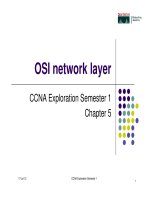Chapter 5 - RIP version 1 CCNA pps
Bạn đang xem bản rút gọn của tài liệu. Xem và tải ngay bản đầy đủ của tài liệu tại đây (1.32 MB, 33 trang )
Chapter 5 - RIP version 1
CCNA Exploration version 4.0
Học viện mạng Bách Khoa - Website: www.bkacad.com 2
Objectives
• Describe the functions, characteristics, and operation
of the RIPv1 protocol.
• Configure a device for using RIPv1.
• Verify proper RIPv1 operation.
• Describe how RIPv1 performs automatic
summarization.
• Configure, verify, and troubleshoot default routes
propagated in a routed network implementing RIPv1.
• Use recommended techniques to solve problems
related to RIPv1
Học viện mạng Bách Khoa - Website: www.bkacad.com 3
RIPv1
• RIP Characteristics
- A classful, Distance Vector (DV) routing protocol
- Metric = hop count
- Routes with a hop count > 15 are unreachable
- Updates are broadcast every 30 seconds
Học viện mạng Bách Khoa - Website: www.bkacad.com 4
• RIP Message Format
• RIP header - divided
into 3 fields
-Command field
-Version field
-Must be zero
• Route Entry -
composed of 3 fields
– Address family
identifier
– IP address
– Metric
RIPv1
Học viện mạng Bách Khoa - Website: www.bkacad.com 5
RIPv1 Message
Học viện mạng Bách Khoa - Website: www.bkacad.com 6
RIPv1
• RIP Operation
• RIP uses 2 message types:
– Request message
• This is sent out on startup by each RIP enabled
interface
• Requests all RIP enabled neighbors to send
routing table.
– Response message
• Message sent to requesting router containing
routing table
Học viện mạng Bách Khoa - Website: www.bkacad.com 7
RIPv1
a)
b)
c)
Học viện mạng Bách Khoa - Website: www.bkacad.com 8
• IP addresses initially divided
into classes
- Class A
- Class B
- Class C
• RIP is a classful routing
protocol: Does not send
subnet masks in routing
updates
RIPv1
Học viện mạng Bách Khoa - Website: www.bkacad.com 9
• Administrative Distance
• RIP’s default administrative distance is 120. When compared to
other interior gateway protocols, RIP is the least-preferred routing
protocol. IS-IS, OSPF, IGRP, and EIGRP all have lower default
AD values.
RIPv1
Học viện mạng Bách Khoa - Website: www.bkacad.com 10
Basic RIPv1 Configuration
• A typical topology suitable for use by
RIPv1 includes:
– Three router set up
– No PCs attached to LANs
– Use of 5 different IP
subnets
Học viện mạng Bách Khoa - Website: www.bkacad.com 11
• Router RIP Command
• To enable RIP enter:
– Router rip at the global configuration prompt.
– Prompt will look like R1(config-router)#.
• To remove RIP process, enter no router rip in global
configuration mode.
Basic RIPv1 Configuration
Học viện mạng Bách Khoa - Website: www.bkacad.com 12
• Specifying Networks
• Use the network command
to:
• Router(config-router)#network
directly-connected-classful-
network-address
• Enable RIP on all interfaces
that belong to this network
• Advertise this network in RIP
updates sent to other routers
every 30 seconds
Basic RIPv1 Configuration
Học viện mạng Bách Khoa - Website: www.bkacad.com 13
Verification and Troubleshooting
• Show ip Route
• To verify and troubleshoot
routing, Use the following
commands:
• Show ip route
• Show ip protocols
• Debug ip rip
Học viện mạng Bách Khoa - Website: www.bkacad.com 14
Verification and Troubleshooting
• show ip protocols
command: Displays
routing protocol
configured on router
Học viện mạng Bách Khoa - Website: www.bkacad.com 15
Verification and Troubleshooting
• Debug ip rip command: Used to display RIP routing
updates as they are happening
Học viện mạng Bách Khoa - Website: www.bkacad.com 16
• Passive interface command
– Used to prevent a router from sending updates through
an interface.
– Example:
Router(config-router)#passive-interface interface-type interface-number
Verification and Troubleshooting
Học viện mạng Bách Khoa - Website: www.bkacad.com 17
• Passive interfaces
Verification and Troubleshooting
Học viện mạng Bách Khoa - Website: www.bkacad.com 18
Automatic Summarization
• Modified Topology
• The original scenario has been modified such that:
– Three classful networks are used:
• 172.30.0.0/16
• 192.168.4.0/24
• 192.168.5.0/24
– The 172.30.0.0/16 network is
subnetted into three subnets:
• 172.30.1.0/24
• 172.30.2.0/24
• 172.30.3.0/24
– The following devices are part of the
172.30.0.0/16 classful network address:
All interfaces on R1
S0/0/0 and Fa0/0 on R2
Học viện mạng Bách Khoa - Website: www.bkacad.com 19
• Boundary Routers
• RIP automatically summarizes classful networks
• Boundary routers summarize RIP subnets from one
major network to another.
Automatic Summarization
Học viện mạng Bách Khoa - Website: www.bkacad.com 20
• Processing RIP Updates
• 2 rules govern RIPv1 updates:
– If a routing update and the interface it’s received on
belong to the same major network then the subnet mask
of the interface is applied to the network in the routing
update.
– If a routing update and the interface it’s received on
belong to a different network then the classful subnet
mask of the network is applied to the network in the
routing update.
Automatic Summarization
Học viện mạng Bách Khoa - Website: www.bkacad.com 21
• Sending RIP Updates
• RIP uses automatic summarization to reduce the size
of a routing table.
Automatic Summarization
Học viện mạng Bách Khoa - Website: www.bkacad.com 22
• Advantages of automatic
summarization:
– The size of routing
updates is reduced
– Single routes are used
to represent multiple
routes which results in
faster lookup in the
routing table.
Automatic Summarization
Học viện mạng Bách Khoa - Website: www.bkacad.com 23
• Disadvantage of Automatic Summarization:
-Does not support discontiguous networks
Automatic Summarization
Học viện mạng Bách Khoa - Website: www.bkacad.com 24
• Discontiguous Topologies
do not converge with
RIPv1
• A router will only
advertise major network
addresses out interfaces
that do not belong to the
advertised route.
Automatic Summarization
Discontiguous Network
Học viện mạng Bách Khoa - Website: www.bkacad.com 25









